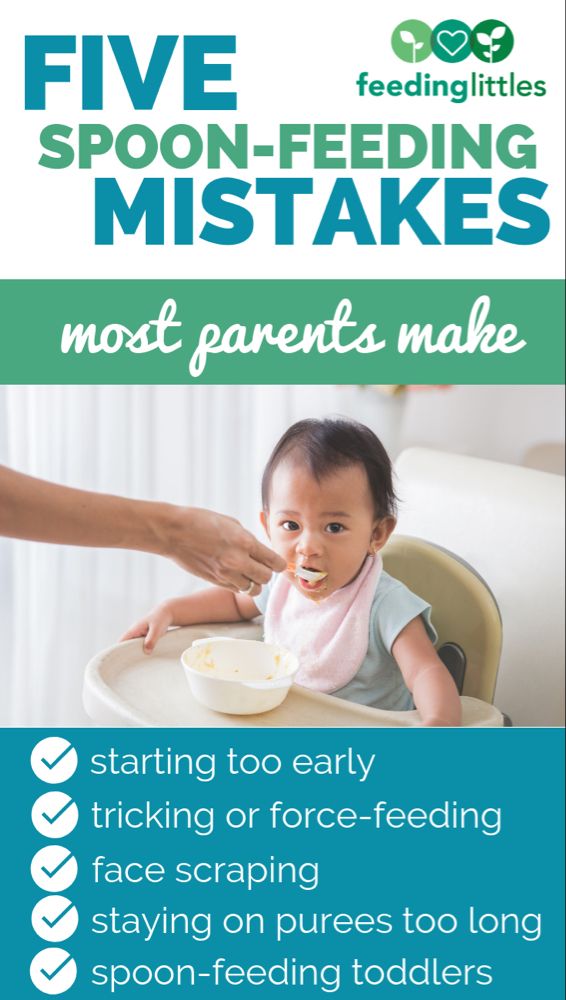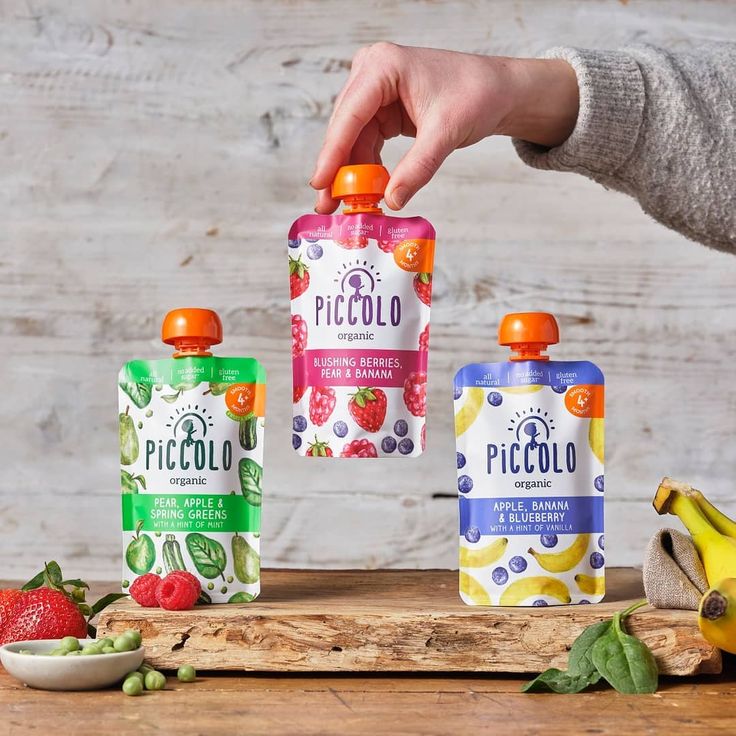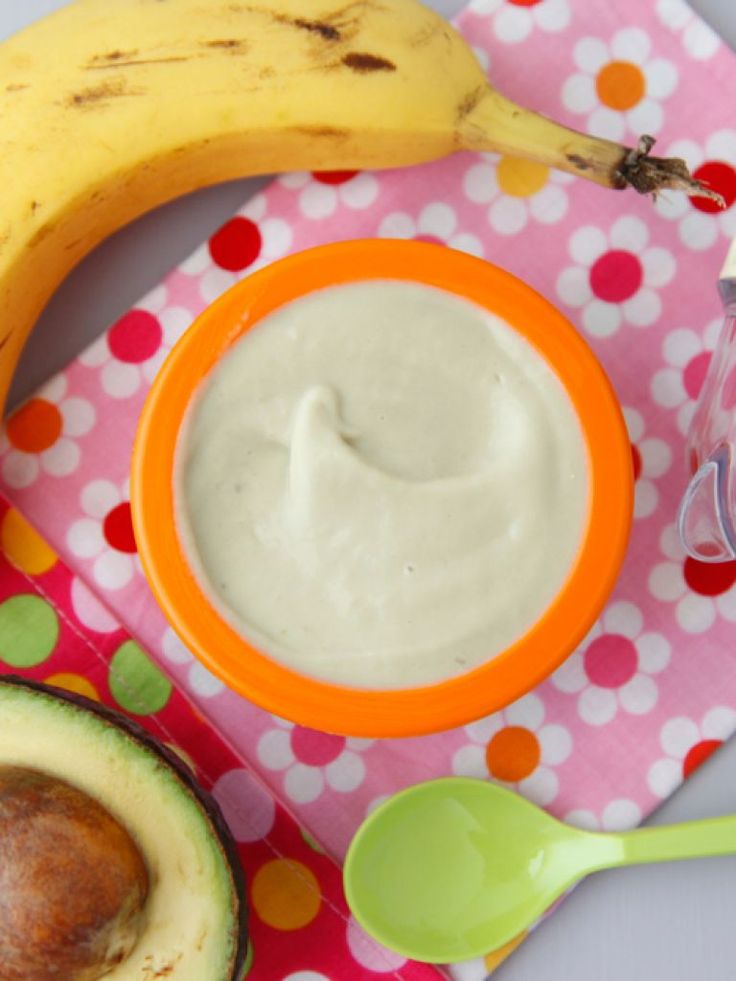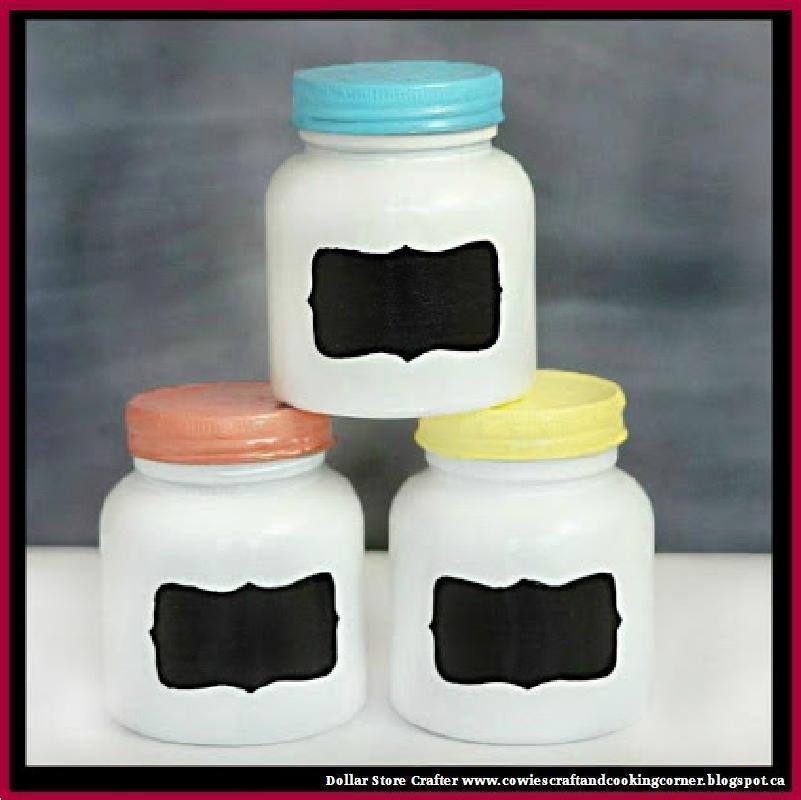When does baby feed self with spoon
When to Introduce a Spoon to Baby
Learning how to self-feed is an important milestone in your baby’s development. The messy, but fun, process of teaching your baby how to use a spoon will be the next step in your baby’s journey to self-feeding.
Teaching your baby how to self-feed is going to be a messy process, but will be worth it in the long run. Your baby's motor skills and development will benefit from learning how to self-feed so it is important to encourage this process to your baby. As you begin to approach the age where your baby is ready to start learning how to self-feed, here is everything you should consider.
Where To Start
Finger Feeding
Before you start to think about introducing a spoon to your baby, you first will want to make sure your baby has been introduced to finger foods. This first step will help your baby begin to develop their motor skills which are necessary to have before figuring out how to use a spoon.
Beginning with finger foods, start with soft foods that you can easily smash with your fingers. This will be the safest and easiest place to start for your baby. Foods such as soft cooked noodles, cut bananas, or steamed veggies are all a good place to begin. Choosing foods that can be cut up into bigger chunks will also make it easier for your baby to be able to pick up.
If you have only been feeding your baby soft foods and purees on your own, you should wait to introduce a spoon until after you have introduced finger foods. At around 12 months, most babies should be feeding themselves finger foods. It is around this stage that you can start to introduce a spoon.
Next Step: Introducing the Spoon
Now that your baby has gotten comfortable with finger feeding, you can take the next step on the self-feeding journey by introducing their first utensil, a spoon. The CDC recommends waiting to introduce a spoon to your baby until they are around 10-12 months old. However, there is no specific age or time that your baby should developmentally be using a spoon. There are many factors that can have an influence on the timing of your baby learning to use a spoon.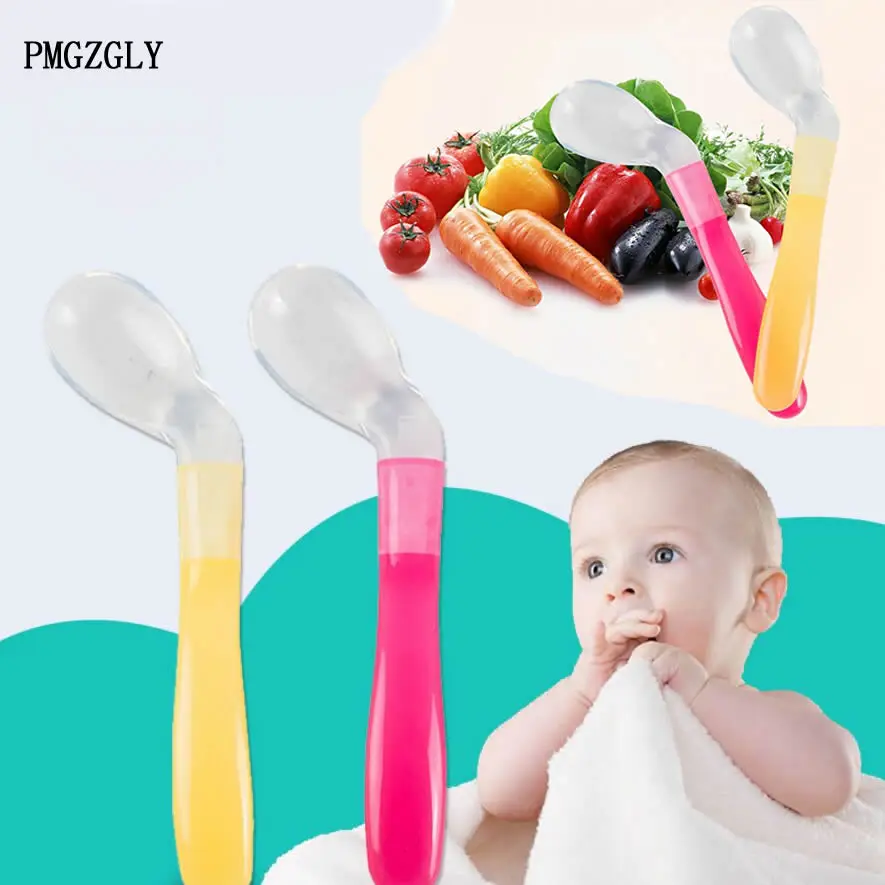
- Fine motor skill development
- Interest in eating independently
- Time they have been eating solid foods
- First introduced to finger foods
These are all factors that can influence when your baby starts to use a spoon to self-feed. Every child is unique so do not worry about whether or not your baby is successfully learning to use a spoon. They will get there eventually!
Signs They Might Be Ready
It can be tricky to know whether or not your baby is ready to take the next step in their development. One sign that your baby is likely ready to start using a spoon on their own is with their body language. Infants typically will turn their heads and clamp their mouth to signal they are full, after the meal. The opposite holds true as they get older. Toddlers will often start to get fussy or throw a tantrum before a meal. If you are noticing that they are appearing disinterested in the spoon you are trying to feed them, let themselves give it a try. This might be their way of telling you they are ready to be more independent.
This might be their way of telling you they are ready to be more independent.
Learn more from Pediatrician Dr. David Hill from the American Academy of Pediatrics about when your baby is ready for solids:
Expected Timeline
Depending on your baby, these milestones will be reached at different times than the families around you. However, here is a general guide to understanding when you should plan on your baby reaching these steps to independently self-feeding.
- 6 months: You can begin to start introducing finger foods to build your baby’s fine motor skills. Remember to choose foods that are soft and easy to squish to avoid any choking hazards.
- 12 months: Around their first birthday, your baby will likely begin showing an interest in using a spoon themselves.
 This is when you can begin letting your child feed themselves thick, soft foods like oatmeal, yogurt, or applesauce.
This is when you can begin letting your child feed themselves thick, soft foods like oatmeal, yogurt, or applesauce. - 15-22 months: Your toddlers should be able to start getting the hang of feeding themselves with a spoon. Around this time, you should also be able to introduce using a fork to feed themselves.
Every baby is different when it comes to reaching these developmental milestones. You should never focus too much on whether or not your baby is “on track.” With both time and practice, your baby will get there.
What are the Benefits of Self-Feeding?
Self-feeding is your baby’s first step to independence. In addition to the new confidence and sense of freedom your baby is experiencing, self-feeding is beneficial to their overall development in the following ways.
- Learning to grasp and hold things firmly
- Gaining hand-eye coordination (learning spatial awareness, strengthening their “visual motor skills”)
- Refining Sensory Process skills (the different textures and sensations of the food they are touching will help to build their sensory processing skills)
Things to Consider
Picking the Right Spoon
In general, any spoon that is not too heavy for your baby to hold is the right spoon.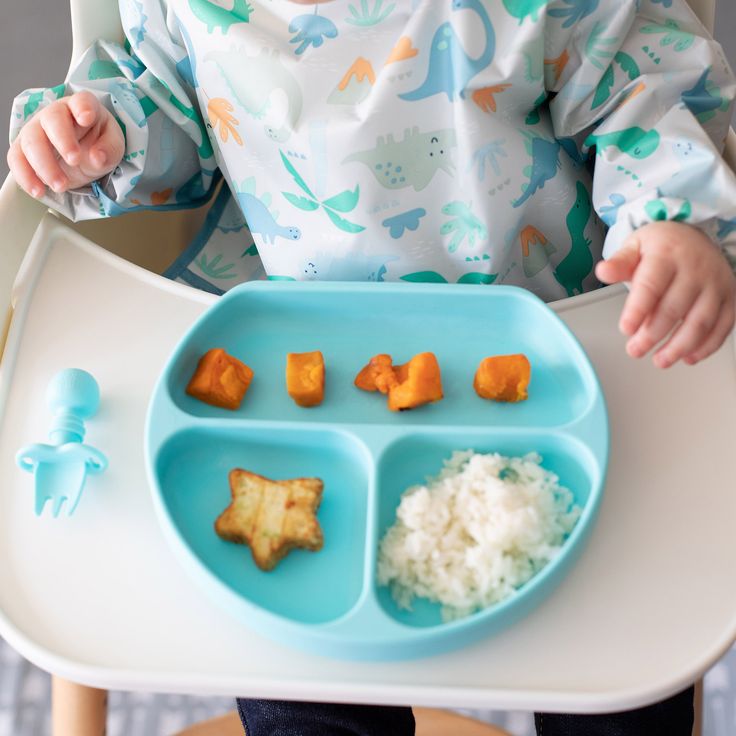 However, it is probably a good idea to purchase a set of spoons that are actually designed to be used for babies. Look for spoons that have a wide, chubby handle that will make it easy for your baby to grab and pick up. A spoon made of rubber or silicone will also be better for your baby because of the soft texture and grippy material.
However, it is probably a good idea to purchase a set of spoons that are actually designed to be used for babies. Look for spoons that have a wide, chubby handle that will make it easy for your baby to grab and pick up. A spoon made of rubber or silicone will also be better for your baby because of the soft texture and grippy material.
Foods to Start With
Get ready for a big mess when it comes to your baby learning how to use a spoon. At first, your baby will likely spend more time exploring and playing with their food, rather than actually eating it. Start with thick foods that will easily stay on the spoon as they learn how to balance and bring the spoon to their mouth. Here are some recommended foods to start with.
- Applesauce
- Cottage cheese
- Mashed peas/carrots
- Mashed potatoes
- Oatmeal
- Pasta
- Pudding
- Yogurt
Introducing the Fork
So, your baby has now mastered the spoon and is ready for their next big step: the fork. It is usually recommended to introduce the spoon before the fork, because a spoon is typically easier for a baby to learn at first. However, some babies do pick up on the fork easier because it requires less balancing and they can stab the food. You will likely want to introduce the fork at around 16-18 months, to give your baby time to first practice and focus on learning how to use a spoon.
It is usually recommended to introduce the spoon before the fork, because a spoon is typically easier for a baby to learn at first. However, some babies do pick up on the fork easier because it requires less balancing and they can stab the food. You will likely want to introduce the fork at around 16-18 months, to give your baby time to first practice and focus on learning how to use a spoon.
What’s Next?
With so many huge developmental milestones being achieved, your baby is rapidly developing. Once your baby has been introduced to the spoon and fork, you can consider moving them from the high chair to a booster seat at the table. By bringing your baby to the table to eat with you, you can help them develop their motor skills quicker. This gives them the opportunity to observe and mirror your actions.
How Can I Help the Process?
The best way you can help your baby is to simply let them experience and explore this new skill for themselves. At first, you'll probably notice that your baby spends more time playing and waving the spoon around. But eventually, they will start to pick up on how to actually use the tool for their self-feeding benefit.
But eventually, they will start to pick up on how to actually use the tool for their self-feeding benefit.
This is a messy, but fun, process. Look into some rubber or silicone splat mats to make the clean up aftermath easier for you. Other than letting your baby explore and have fun with the learning process, here are some things you can do to help your baby with practicing their new skill.
- Demonstrate it for them: Your baby is looking to you for guidance, so show them how it is done! Have them watch you use a spoon to feed yourself the yogurt or oatmeal and then have them try it for themselves. Over time, they will continue to mirror your actions for how to self-feed.
- Hand-Over-Hand Method: First, let your baby grab for the spoon themselves. Once they are holding the spoon, see if they can dip the spoon and scoop up the food. You can place your hand over their hand and help guide the food into their mouth. Your baby is still learning all the basics like where their mouth even is and how to scoop food using the spoon so you can help show them the ropes for the first few times.

- Stick to Thick Foods: To make it easier for your baby to scoop and bring the food into their mouth, stick to thick foods at first. Avoid foods that can easily fly off the spoon (rice, cereal, etc.) until they have gotten used to the process.
Baby-Led Weaning: What is it?
Baby-Led Weaning is a popular form of teaching self-feeding. The process skips feeding soft foods and purees and goes straight to finger foods starting at around 6 months. Registered dietician, Clancy Cash Harrison, author of Feeding Baby, says “Baby-led weaning supports the development of hand-eye coordination, chewing skills, dexterity, and healthy eating habits,” she says. “It also offers babies an opportunity to explore the taste, texture, aroma, and color of a variety of foods.”
What makes baby-led weaning successful, is that your baby will recognize that in order to eat, they need to learn how to do it themselves. It gives an extra nudge into independence.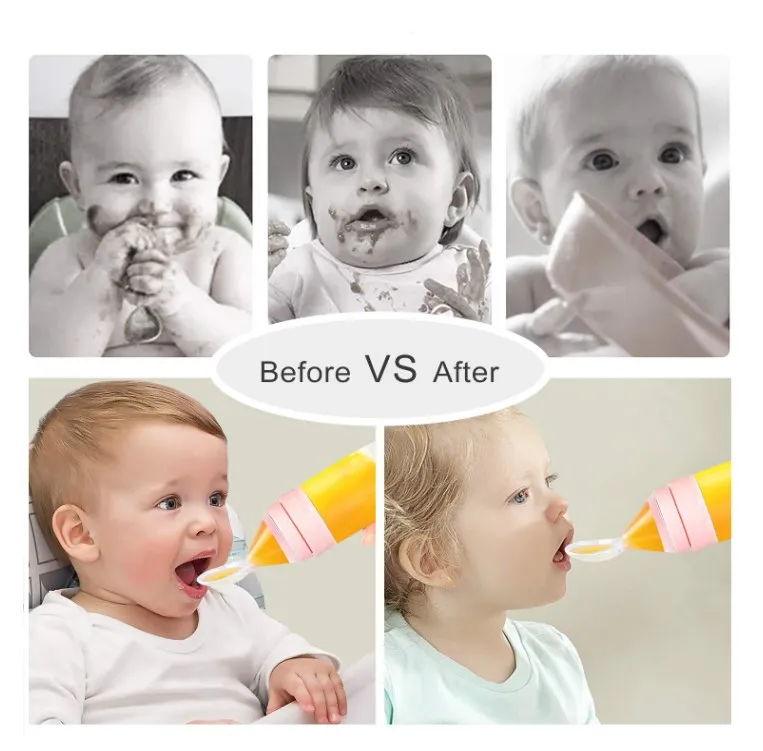 However, parents can obviously step in when needed, in order to make sure their baby is getting enough nutrition from food.
However, parents can obviously step in when needed, in order to make sure their baby is getting enough nutrition from food.
Starting at about 6 months, or whenever your baby is able to sit unassisted in a high chair, you can begin baby-led weaning. Your baby might not have fully developed their chewing skills so breast milk or formula will still need to be their main source of nutrition until at least 10 months old.
The best foods to begin with are soft, easy to squish foods like bananas, steamed broccoli, or avocado. Try cutting the foods into bigger pieces to make it easier for them to pick up. By starting at 6 months, you will help your baby develop the pincer grasp. When considering foods to start with, texture is key. Since your baby does not have the fully developed chewing skills, you will want to make sure any food you are giving them is very soft to avoid a choking hazard.
If you are thinking of starting baby-led weaning, consider a mixed approach. The first few months of baby-led weaning might be more exploring, and less eating.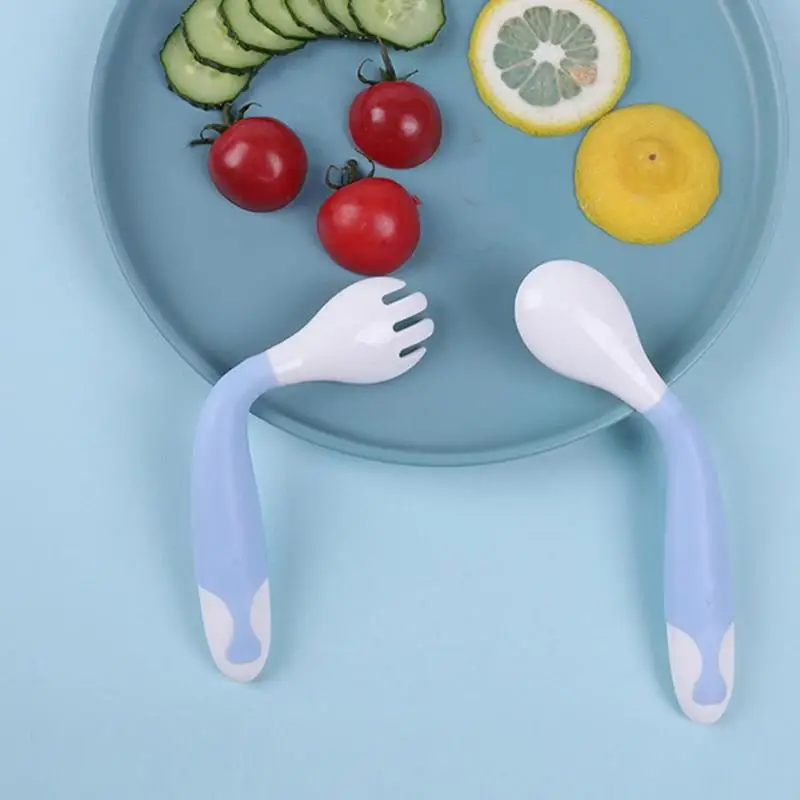 Do not feel pressure to fully abandon breast milk, formula, or purees. Not all children will be ready for baby-led weaning and finger feeding at 6 months. Focus on making sure your baby is getting enough food, rather than trying to get them to self-feed.
Do not feel pressure to fully abandon breast milk, formula, or purees. Not all children will be ready for baby-led weaning and finger feeding at 6 months. Focus on making sure your baby is getting enough food, rather than trying to get them to self-feed.
The most important thing to take away from both self-feeding and baby-led weaning is to let your baby lead the process. Let them be the one to reach for the spoon, show their curiosity, and explore their growing independence. Your baby will be most successful if you let them guide you in this process.
--------------------------------
All health-related content on this website is for informational purposes only and does not create a doctor-patient relationship. Always seek the advice of your own pediatrician in connection with any questions regarding your baby’s health.
These statements have not been evaluated by the Food and Drug Administration. Products are not intended to diagnose, treat, cure or prevent any disease.
See the FDA Peanut Allergy Qualified Health Claim at the bottom of our homepage.
Teaching Your Baby to Self-Feed
Read time: 5 minutes
What should I know about teaching my baby to feed themself?Signs your baby is ready to self-feed
Ideas for first finger foods
Tips for introducing spoons and cups to your baby
As your baby becomes more experienced with eating, you may notice them becoming more interested in feeding themself. This transition to self-feeding usually starts between 7 and 9 months.1,2,3
Signs your baby is ready to self-feed includeGrabbing the spoon while you are holding it
Reaching for food from their (or your!) plate
Even grabbing other objects, like toys, and bringing them to their mouth4,5
Once your baby starts showing an interest in feeding themself, it’s important to provide many opportunities for them to practice this skill. The key to mastering self-feeding is to let your baby try and try again.
The key to mastering self-feeding is to let your baby try and try again.
Don’t wait until your baby’s teeth emerge to start finger foods! Babies do not actually need teeth in order to enjoy foods beyond purees. In fact, the teeth we use to chew are the molars, and those teeth generally don’t come in until well after baby’s first birthday.15
Babies’ gums are incredibly strong – if your little one has ever gnawed on your finger when teething, you know! And as long as the foods you present to your baby are size and texture appropriate, they can chew perfectly well without a full mouth of teeth.14
Ideally, the food you provide your little one should be soft and pea-sized to prevent choking. Make sure the food is ‘smushable’ between your fingers so that it’s soft enough to be gummed by your baby.
How to start teaching your baby to self-feed with finger foodsA good way to start is placing a few small pieces of food on your baby’s highchair tray. Let your baby feel it. It may seem as if baby is just playing with the food, but touching and playing is a step in their learning process.2,5
Let your baby feel it. It may seem as if baby is just playing with the food, but touching and playing is a step in their learning process.2,5
Initially, your baby may grab for the food with a raking motion, using the entire fist to move the food toward their mouth. Grabbing the food in this way is called the palmer grasp, which is when baby’s fingers close over an object (such as your finger) in the palm of their hand.16
Around 9 months, your little one will develop the fine motor skill of grasping food with their thumb and forefinger, called the pincer grasp.5
Read more: Introducing Solids: First Foods and Advancing Textures
When to practice self-feedingYou can go about practicing self-feeding in many ways. First, try setting aside time at the beginning of the meal for practice. Since baby is hungrier at the start, this may help in motivating your little one to bring the food to their mouth themself.
Another way to try is to simply leave several pieces of food on baby’s tray to play and practice with while you alternate with spoon feeding. Allow your little one to try and put food in their mouth, then practice chewing and swallowing. Be sure that baby’s mouth is clear of food before offering anything from the spoon.
If your baby gets frustrated, allow them to finish the meal and eat how they normally would (such as with spoon feeding). Just remember to keep trying at other meals throughout the day (and every day).
Read more: Meal Plan for 6 to 9 Month Old Baby
First finger foodsThe foods you give your baby to practice self-feeding should be soft, easily ‘smushed’ between your fingers, and cut into small pea-sized pieces.
Here are some ideas for first finger foods:
Small pieces of ripe, soft bananas, avocados, peaches, mango, kiwi
Soft cooked sweet potatoes, carrots, butternut squash, turnips
Grated or soft cooked (skinless) apples and pears
Soft cooked whole grain pasta
Scrambled eggs
Cubes, strings, shredded, or small pea-sized pieces of cheese
Cooked shreds, small diced pieces, or ground cooked chicken, fish, or turkey
Berries cut into quarters
Beans cut into halves or quarters
In addition to the above ideas, your baby can eat bits of what you eat (without added salt or sugar) including different fruits, veggies, grains, meat, beans, spices and seasonings as long as the foods are small and soft enough to reduce choking risk.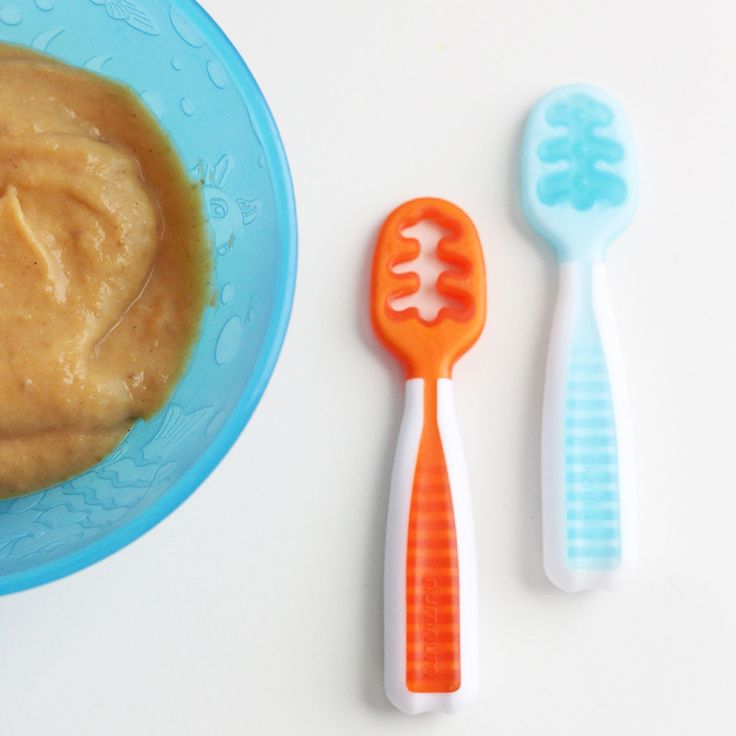
Foods that pose a risk of choking should be avoided. Examples include nuts, whole grapes, hot dogs, raw carrots, raisins, popcorn, and portions of food that are too large.14 Also note that honey should not be given to infants before the age of 1 year.
Read more: Preventing Choking in Infants and Toddlers
Time to practice with spoons and cupsLearning how to use spoons and cups not only involves demonstrating how to use each one, but also allowing your baby lots of practice both with your help and without. Let your little one get messy as they step into their independence with eating and drinking!
Teaching your baby to use a spoonAfter your baby masters self-feeding with their hands, the next step is offering utensils. Most children become good at using spoons and forks to self-feed between 15 to 18 months, but that doesn’t mean you need to wait until then to start exposing them to utensils. 1,6,7
1,6,7
Just as your baby needed a lot of practice eating with their hands, they will also need many opportunities to attempt eating with utensils. A good way to begin encouraging this transition is to give them their own baby or toddler-friendly spoon or fork.
Teaching your baby to use a cupLearning to drink from a cup can also begin around this time.4,7 Use an open, sippy, or straw cup and allow your little one to practice with a small amount of water. Since formula and/or breastmilk will still provide a large amount of nutrition and all of the hydration for your little one at this age, only about 4 to 8 ounces of water total spread through the day are recommended.8
Letting your baby drink water from a cup on their own will not only build their fine motor skills (which may include lots of spills!), but will also help them form the important habit of drinking water. 8
8
Which should you use: cups? Sippy cups? Straw cups? Learn more here: Transitioning to Cups for Babies and Toddlers
Which foods to use when practicing using a spoonThicker foods like oatmeal, mashed sweet potatoes, or yogurt blended with fruit are good practice foods since they will more easily stick to the utensil. It will be messy for a while but just remember that practice makes progress.
Once your baby has gotten the hang of dipping the utensil into the food and bringing it to their mouth, consider giving baby their own small bowl. There are some bowls with suction cups on the bottom and some that are attached to a mat – these may help prevent too many spills.
Let your baby to feed themself from their bowl while still feeding them from yours. Soon enough they’ll be eating a full meal without your help!
Remember, it is a learning process; it will take quite a while before your little one is neatly and skillfully feeding themself. In the meantime, have fun and be prepared to get messy!
In the meantime, have fun and be prepared to get messy!
It’s important to monitor your baby as they begin to eat more independently. Your baby is not only getting used to a new way of eating, but new textures too. Remaining by your baby during meals will allow you to monitor their tolerance for new textures and the amounts they are putting into their mouth.9
Know the difference between gagging and chokingGagging is the body’s natural defense against choking and is very common when babies start eating solid foods.10,11 Gagging may occur if the baby has too much food in their mouth or if the food moves towards the back of the mouth before they have chewed it sufficiently. While your baby may look scared and be making gagging noises, baby’s airway is not blocked. The gag reflex helps baby move the food back toward the front of the mouth so they may chew it more before swallowing.
The gag reflex helps baby move the food back toward the front of the mouth so they may chew it more before swallowing.
Choking is when a piece of food becomes lodged in the airways causing baby to stop breathing.12 Your baby will be silent and perhaps flailing their arms. Choking is life threatening and requires immediate attention.
Learn more: Preventing Choking in Infants and Toddlers
Expect and embrace the messTeaching your baby to feed themself will be messy. Invest in a few good bibs or apron type smocks that can better catch the food. Consider placing an old towel underneath the highchair if you are concerned with food falling on the floor. Keep a damp washcloth or paper towel by your side to help with spills.
Enjoy family mealsBabies learn from you! If your baby is eating meals with the rest of the family, they will observe how everyone else is using their utensils to feed themselves, eating healthy foods, as well as other appropriate mealtime behaviors.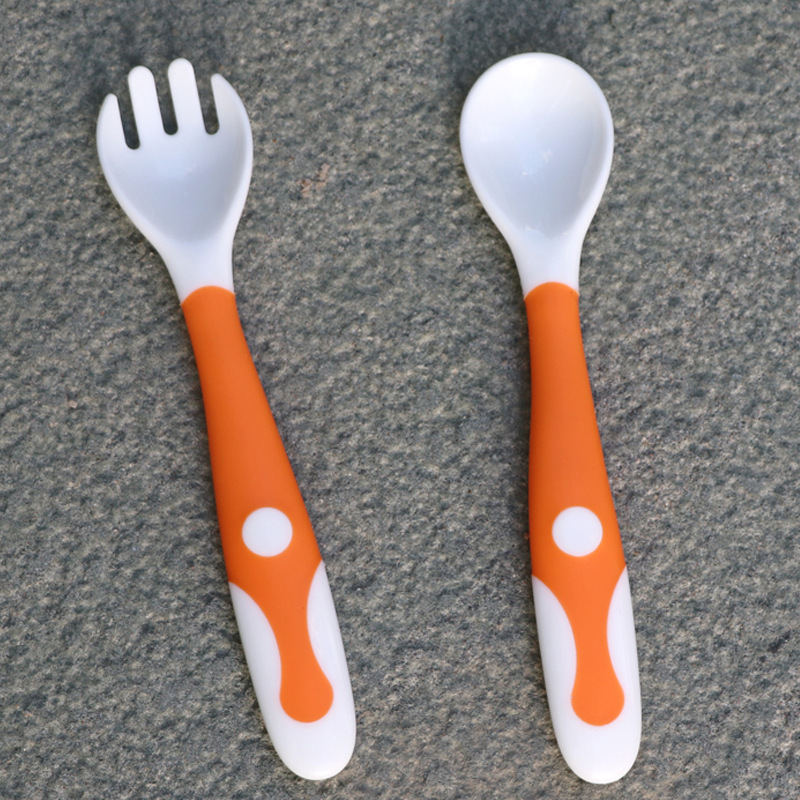 4,13
4,13
Read more: Family Meals: Developing Healthy Eating Patterns
Be patientLearning to self-feed takes time. Allow plenty of time for meals and never rush your baby to finish. Your little one is eating at the pace they are most comfortable with, allowing them to boost their learning.
Let's Chat!We know parenting often means sleepless nights, stressful days, and countless questions and confusion, and we want to support you in your feeding journey and beyond.
Our Happy Baby Experts are a team of lactation consultants and registered dietitians certified in infant and maternal nutrition – and they’re all moms, too, which means they’ve been there and seen that. They’re here to help on our free, live chat platform Monday - Friday 8am-6pm (ET). Chat Now!
Read more about the experts that help write our content!
For more on this topic, check out the following articles:Introducing Solids: Signs of Readiness
Learning to Love Healthy Foods
Understanding your Baby’s Hunger and Fullness Cues: Responsive Feeding
Introducing Solids: Baby Led Weaning
Feeding Tips for Healthy Weight Gain in Infants and Toddlers
Nutrient Needs and Feeding Tips for 6 to 12 Month Olds
Sources
Child and spoon.
 When to teach a child to cutlery?
When to teach a child to cutlery? Approximately by the 9-10th month, children become interested in cutlery.
Approximately by the 9th-10th month, children develop an interest in the cutlery that parents use and with the help of which mother gives complementary foods.
While eating, the baby tries to grab a spoon, look at it, lick it, and is already trying to copy what mom does: scoop up porridge or puree and bring it to her mouth.
Of course, the first clumsy attempts end in splashing and spilling food in all directions. Some kids love this fun and instead of learning to wield a spoon, they willingly play with it (of course, if mom allows).
At the same time, taking a toy from a little bully becomes a real problem - after all, the baby does not want to part with it at all. At this moment, the mother needs to intervene in the situation and try to direct it in a peaceful direction, that is, to teach her child to use the cutlery for its intended purpose.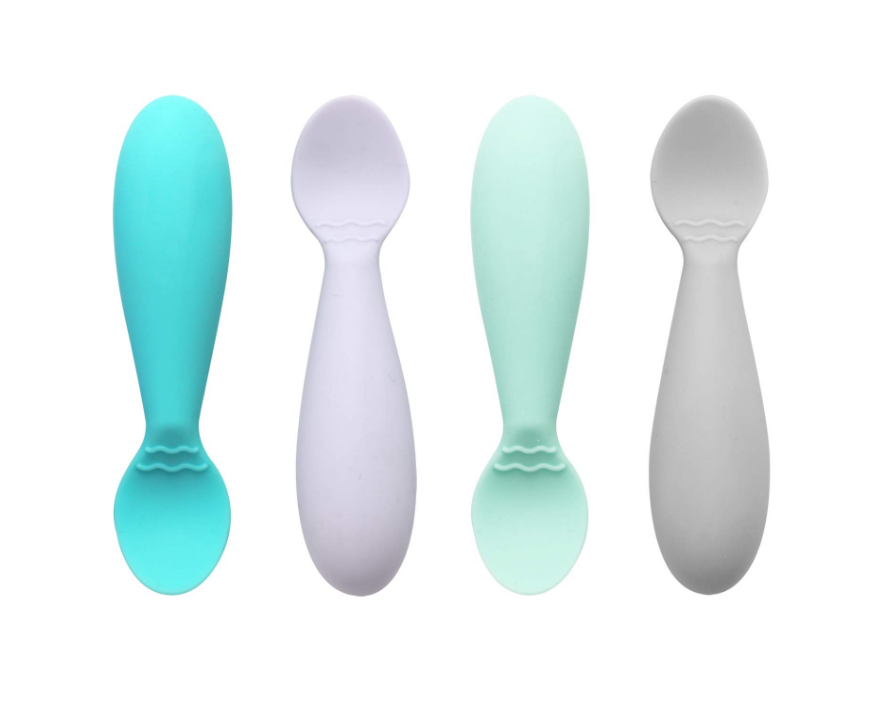
When should I start teaching my baby to eat with a spoon?
Starting from 10-11 months of age, a child may well learn how to use a spoon correctly. During feeding, put a spoon in his handle. For the first test, be sure to prepare your baby's favorite dish - let him not have the desire to scatter it in vain.
Of course, in any case, the learning process will add extra trouble for you - cleaning and washing. The baby will climb into the plate with a spoon, try to scoop up food, as a result of which you will then collect it from clothes, tables, floors.
Patience is important here. And you reassure yourself that such independent actions increase the appetite and mood of the little one. Each time the process will go cleaner and cleaner, and the tiny handle will hold the spoon more and more confidently.
Which spoon to start with?
It's best to give your baby a special silicone spoon first - they are completely safe and fit comfortably in a child's hand.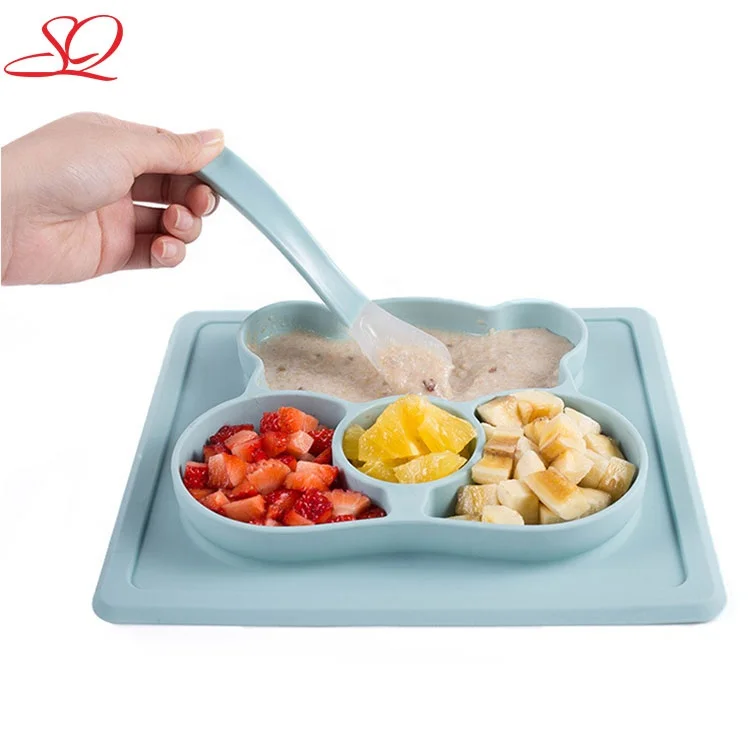 Alternatively, you can try a dessert spoon, because it looks more like the one your parents eat. At the same time, buy a children's bowl with high edges and suction cups. And it’s better to have several of them - with different pictures on the bottom, so that it would be more interesting for the baby to get to the bottom as soon as possible.
Alternatively, you can try a dessert spoon, because it looks more like the one your parents eat. At the same time, buy a children's bowl with high edges and suction cups. And it’s better to have several of them - with different pictures on the bottom, so that it would be more interesting for the baby to get to the bottom as soon as possible.
First learn how to eat mashed potatoes and cereals, only then move on to liquid dishes. Do not forget that each baby has his own development schedule, and if he does not want to learn to eat with a spoon, it's okay, it will come to him a little later.
At first, the baby will hold the spoon in the way that is comfortable for him - perhaps in a fist. If at this time you start to pull it up and teach it to hold it correctly, most likely, you will only achieve that your treasure does not want to eat on its own at all.
We eat at the common table
It is better to do things differently — to seat the baby at the common table more often.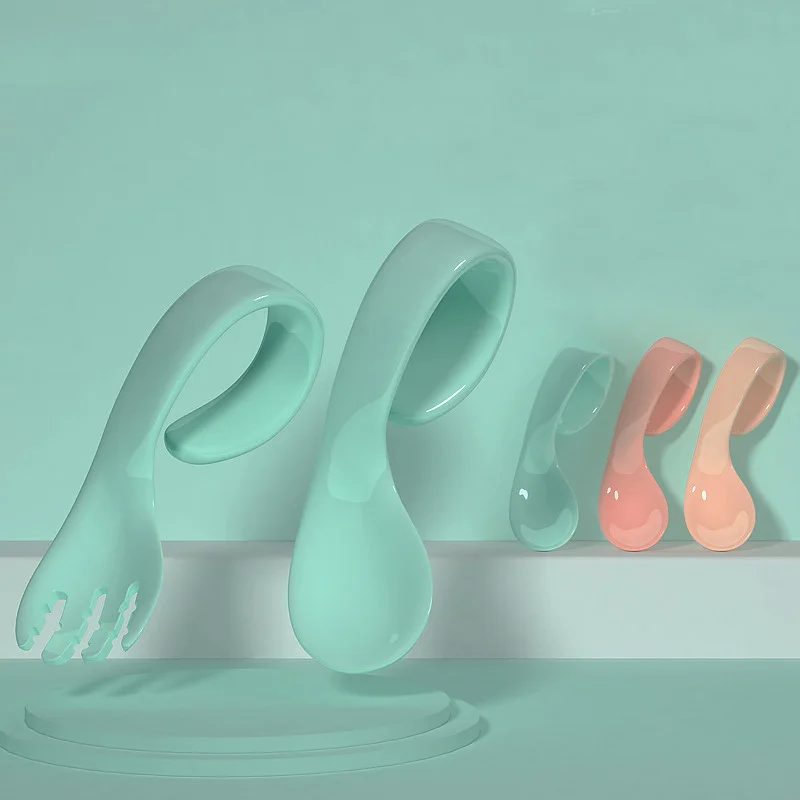 He will see how you eat and try to copy your behavior.
He will see how you eat and try to copy your behavior.
Eating at the same table with the whole family for a child will be a real pleasure - this is communication, new impressions, and gaining experience - in particular, behavior at the table. By the way, this method is very useful for increasing the appetite of little ones. Do not forget to set a positive example for your baby - do not talk at the table, do not fidget, etc.
If the child does not want to eat with a spoon at all and continues to take food with his hands, try the opposite method - sometimes it works. Everyone at the table eats with spoons, but do not give the crumbs a spoon. The same with food - everyone eats and praises, and let the baby sit for a while with an empty plate. He will reach out and ask!
Rules of etiquette
If a child under two years of age has not yet learned how to hold a spoon, you can try to talk to him about this topic and point out mistakes, appealing that he is already big and should do everything right. The spoon is taken with three fingers - thumb, middle and index, slightly below its wide part. When the baby learns this, teach him to scoop food correctly, bring it to his mouth with the side, and not with the tapering part.
The spoon is taken with three fingers - thumb, middle and index, slightly below its wide part. When the baby learns this, teach him to scoop food correctly, bring it to his mouth with the side, and not with the tapering part.
Explain to the child that you should eat slowly, not open your mouth wide and not make any sounds. After three years, you can buy a children's fork, because from this age the baby already clearly understands which objects are traumatic. Start with soft foods - banana slices, cutlets, and over time, learn to prick harder foods.
Should I force my baby to eat with a spoon?
Before you insist that your child eat with a spoon, figure out why you need it to happen earlier, because there is no strict time limit.
Do you remember when you have ever seen a 13-year-old teenager or an adult who did not know how to use a spoon? If you do not rush and do not work "ahead of the curve", this process will go unnoticed and by itself. And you will only have to be surprised after the fact: “Did this really need to be taught? He himself learned…”
How to teach a child to eat with a spoon by himself? Algorithm of actions and work on errors.

How to teach a child to eat with a spoon? How to teach him to eat himself? How to learn to hold a spoon?
Instructions for parents who want to teach their child to eat with a spoon on their own. What should I do if my child refuses to eat on his own? Rules of accuracy and safety at the table. Mistakes of parents, or how not to teach a child to eat with a spoon.
The age of 10-12 months is the period of unprecedented activity of the baby. From this moment on, the child, with genuine enthusiasm, is interested in everything that surrounds him: puts things in order in the lockers, pours out toys from the basket and collects them, drinks from a bottle or cup on his own, tries to put on socks, tights or a hat, unbuttons buttons and zippers ... This the same trend can be traced in relation to food: the baby can refuse the help of adults, wielding a spoon on his own.
Of course, you can't do without scattered porridge, spilled soup and soiled clothes. But this is the best experience for a child to learn how to feed on their own. And if parents show restraint and patience, by the age of one year the baby himself will be able to eat the first and second courses with a spoon. As a rule, by the age of one and a half years, the independence of the crumbs in relation to food is complemented by accuracy. But is it possible to speed up the process of accustoming to independence? How to teach a child to eat with a spoon?
And if parents show restraint and patience, by the age of one year the baby himself will be able to eat the first and second courses with a spoon. As a rule, by the age of one and a half years, the independence of the crumbs in relation to food is complemented by accuracy. But is it possible to speed up the process of accustoming to independence? How to teach a child to eat with a spoon?
Contents
- Five rules every mother needs to know
- At what age should you give your baby a spoon
- What should be the right spoon?
- How to teach a child to eat with a spoon - 10 simple tips
- When can you teach a child to eat on his own?
- What should I do if my child refuses to eat on his own?
- Mistakes of parents, or how not to teach a child to eat with a spoon
- Don't forget!!!
- Consider your child's personality
- Interest in eating
- How to overcome resistance
- What you need to know when getting a new experience
- So .
 .. Algorithm of actions
.. Algorithm of actions - Useful tips
Five rules that every mother needs to know when you can give a child
spoon and start learning to eat on your own. Even if the baby does not show a desire to do without his mother's help, at the age of about a year and a half it is worth addressing this issue.
Years of experience shows that there are a number of rules or tricks, as you please, observing which, the mother will be able to quickly and almost painlessly teach the child to use cutlery.
Rule one: hunger is not an aunt
When a child wants to eat, he will strive to satisfy his hunger and he will not have time for toys, entertainment and research. On an empty stomach, you can’t really clear up, so it’s better to give a child a spoon when he wants to eat. To begin, put a spoon in the baby's hand and help him with your hand. Then, when he becomes more independent, try to take part in feeding him as little as possible.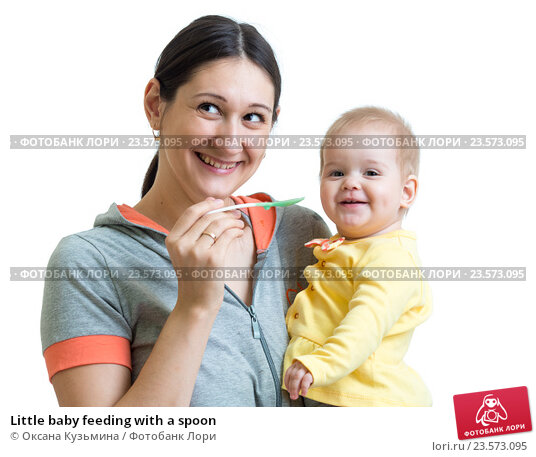
Rule two: you can't play with food!
As soon as the baby is full, he will start to taste the food with his fingers, smear it on the face, table, walls, throw it on the floor. At such moments, it is best to remove the plate and spoon, otherwise in the future the child will not understand the difference between games and food.
Rule three: don't go against nature!
Never insist that the bread should be held with the left hand and the spoon with the right. Up to three years, it is quite normal for a child to try to eat with both his right and left hands, there is nothing to worry about. In addition, if your child is left-handed, then by retraining him to the right hand, you will only confuse the work of his brain, which in the future may affect development. Don't go against nature, leave a lefty lefty.
Rule four: about delicious and beautiful food
First, teach your child to eat on his favorite dishes.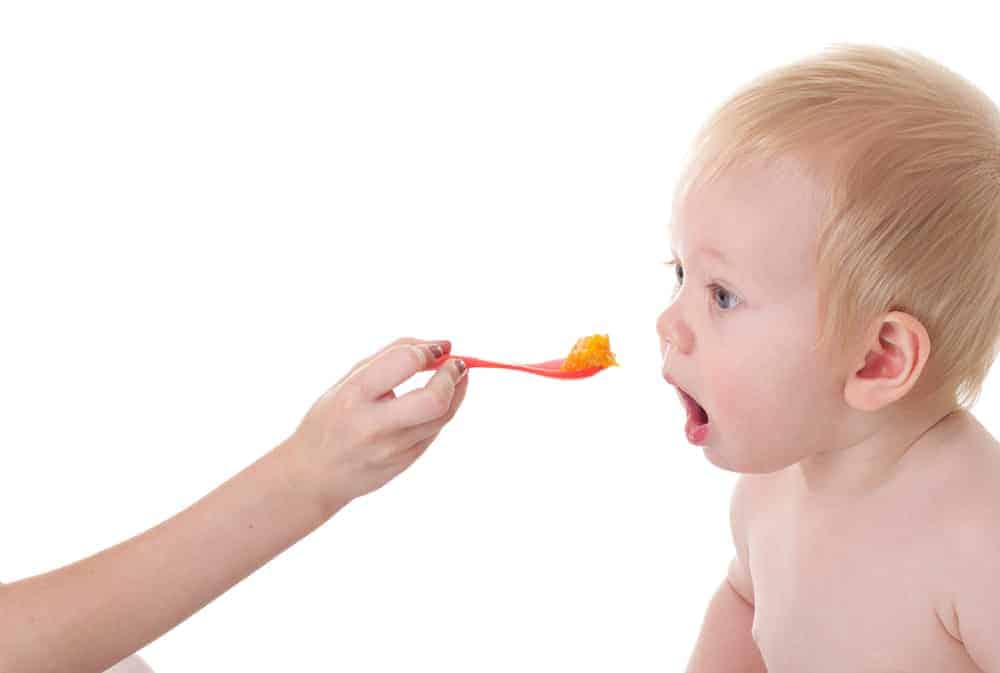 It doesn't matter whether it's potatoes, porridge or a cutlet - give your baby a spoon or a fork. However, if you see that it is still uncomfortable for him to eat with a fork, change it to a spoon. It's okay if at first he helps himself with his hands. Just keep your tissues ready.
It doesn't matter whether it's potatoes, porridge or a cutlet - give your baby a spoon or a fork. However, if you see that it is still uncomfortable for him to eat with a fork, change it to a spoon. It's okay if at first he helps himself with his hands. Just keep your tissues ready.
By the way, many mothers claim that beautifully decorated dishes cause a child more appetite and interest than a regular plate of food. An omelette in the form of a funny face, a salad or vegetables in the form of a bouquet of flowers - everything that your imagination is capable of will be appreciated by your baby.
Rule five: take care of your nerves!
Many people are accustomed to cleanliness from childhood and experience almost physical discomfort from the mess that surrounds them. Accept the fact that while the child is learning to eat on his own, your kitchen (or dining room) will not be very clean. You can and should fight this, but the main thing is not to overdo it.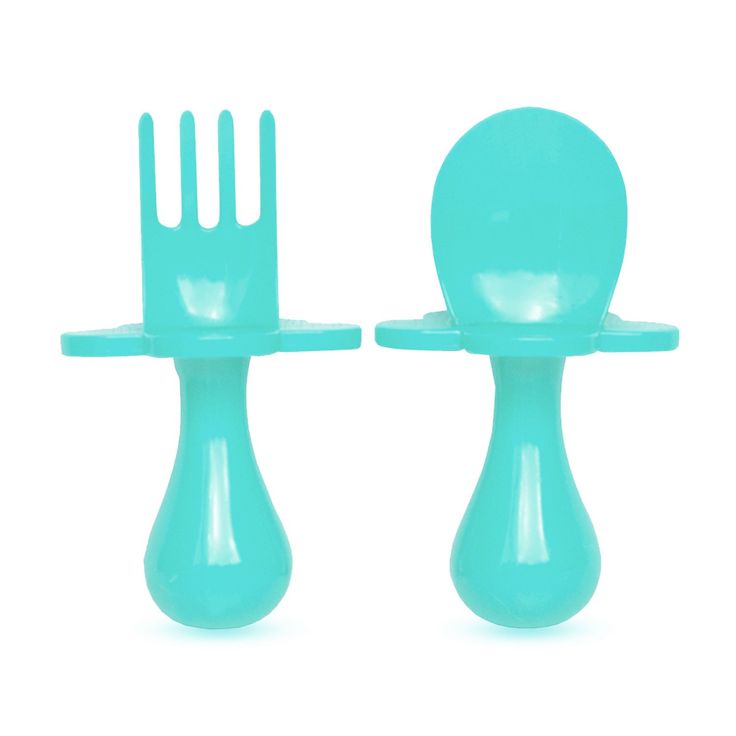 You should not wipe every drop spilled past your mouth, let the child finish eating calmly, and then do the cleaning, and best of all with him, then he will know what to clean up after himself, and even better - try not to get dirty. At what age should a child be taught to clean? It is best from the very beginning - then the desire for purity will be in his blood. In any case, it is always easier to educate than to re-educate later.
You should not wipe every drop spilled past your mouth, let the child finish eating calmly, and then do the cleaning, and best of all with him, then he will know what to clean up after himself, and even better - try not to get dirty. At what age should a child be taught to clean? It is best from the very beginning - then the desire for purity will be in his blood. In any case, it is always easier to educate than to re-educate later.
In a warm room, you can do without bibs if you put the baby to eat naked. Note that it is much easier to wipe a bare stomach than to wash a mountain of soiled linen every day. In the cool season, you can put on a baby a special oilcloth jacket with a bib already sewn into it - they are sold in almost all children's stores, they are easy to wash, dry quickly and make life much easier for mom.
At what age should a child be given a spoon
A child should be taught to eat independently as early as possible. This does not mean that you can give table manners lessons to a three-month-old baby. First, the baby must learn to sit confidently at the table, develop coordination of movements. Now he already feels great in a high chair and at dinner he tries to take away cutlery from his mother. Give him another spoon, let him try to scoop up porridge or mashed potatoes. The baby begins to understand that the spoon is not needed at all for playing, but for getting food. This usually happens after 9months, but each baby develops differently. Someone after six months is already trying to scatter food on the table, and someone has to be fed almost up to 3 years.
First, the baby must learn to sit confidently at the table, develop coordination of movements. Now he already feels great in a high chair and at dinner he tries to take away cutlery from his mother. Give him another spoon, let him try to scoop up porridge or mashed potatoes. The baby begins to understand that the spoon is not needed at all for playing, but for getting food. This usually happens after 9months, but each baby develops differently. Someone after six months is already trying to scatter food on the table, and someone has to be fed almost up to 3 years.
By the age of one, the child makes the first attempts to control the spoon, he already wants to eat by himself. Not everything works out, often food passes by the mouth. The main thing is that he learns to imitate the movements of adults. According to the norms, the baby begins to eat on its own by the age of one and a half years, but a lot depends on the temperament of the child and the views of the parents. Often, for mothers who give little freedom of action, the child begins to eat independently only at 2 years old, while children in the nursery group master the skill of independent nutrition on average at 1 year and 3 months.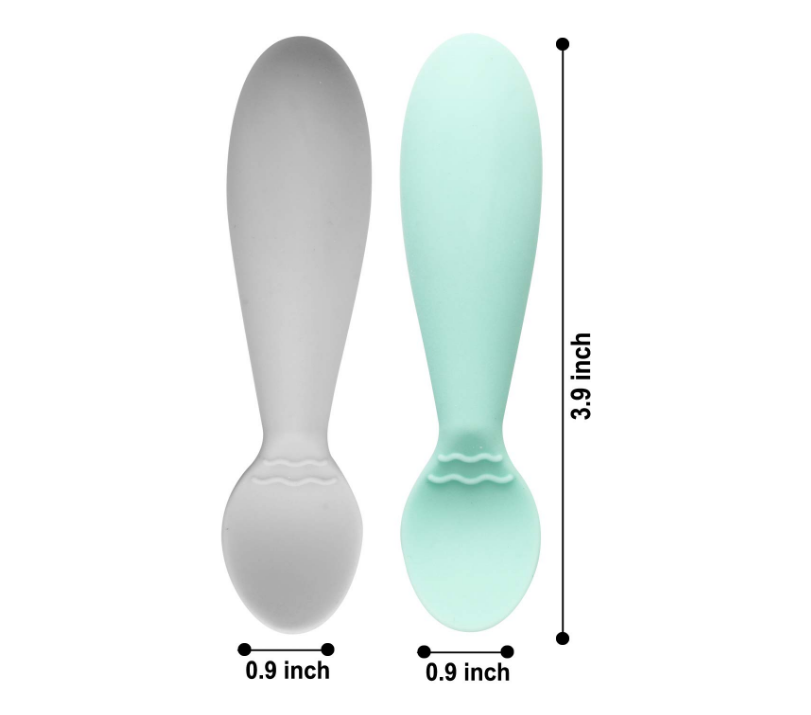
According to experts, training should begin no later than 10 months, and by the age of one and a half, the child will have mastered this science. These skills will be very useful to him: ahead of entering a kindergarten, and there the ability to use cutlery is a mandatory requirement. Each new skill increases the self-esteem of the baby, he is proud that without the help of his mother he was able to climb a chair or eat porridge. If you share his joy, show how pleased you are with the achievements of your child, his desire to learn something will increase several times.
Do not forget that the desire to master a new business arises from a certain age, and fades away after a while. A busy mother tries to feed the baby as quickly as possible and does not remove scattered food from the table, floor, walls and clothes. The child is comfortable: at the table, his task is only to open his mouth, everything else will be done by the parents. And suddenly, at about 3 years old, he hears that he should eat himself. The time when the kid wanted to learn this was missed, now the ability to wield a spoon does not attract him, so tears and tantrums cannot be avoided. Be attentive to the interests of your children - as soon as you notice their desire to learn a new skill, support this endeavor.
The time when the kid wanted to learn this was missed, now the ability to wield a spoon does not attract him, so tears and tantrums cannot be avoided. Be attentive to the interests of your children - as soon as you notice their desire to learn a new skill, support this endeavor.
What should be the correct spoon?
So that after the first experience the baby does not throw away the spoon with a roar and does not remember the insult for a long time, cutlery must be chosen correctly. You can purchase a special anatomical spoon. It fits comfortably in a tiny hand, it will be easy for the baby to scoop up food. There is only one drawback: the child will not learn to eat with ordinary cutlery and after a few months he will have to be retrained.
The first spoon should definitely please the baby. Sometimes children, for unknown reasons, categorically reject some object, cry at the mere sight of it. If this happens, do not force him to use unloved appliances, get another spoon.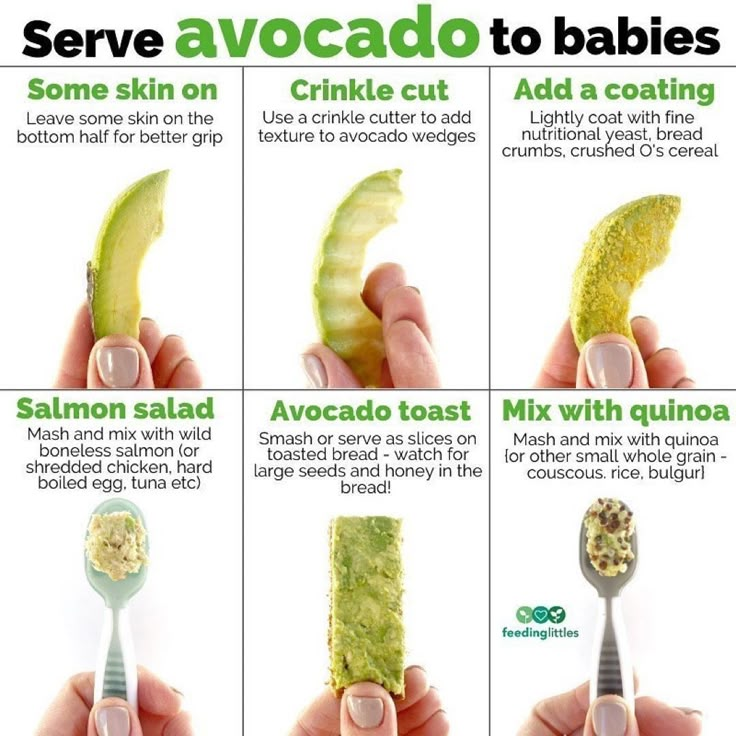 In doing so, consider the basic requirements.
In doing so, consider the basic requirements.
Children's dishes should be:
- small;
- light:
- safe:
- comfortable.
Carefully choose the material from which children's cutlery is made. Traditionally, babies were fed from a metal teaspoon. It is better that it be made of silver, this metal has the ability to destroy the infection.
On sale you can find models from different materials.
- Rubber (silicone) spoon is soft, fits comfortably into a small mouth and does not injure it in case of careless movement.
- Plastic is good because it can be used to make products of different colors. Colorful light cutlery is very popular with kids. In addition, you can find a plastic spoon that changes color depending on the temperature of the food. But in any case, it is always important for a mother to try the food she is going to feed the child so as not to burn him, so this quality is more likely to entertain the baby and is useful for experiments and games with water to a greater extent than for feeding.

- For kindergarten training, it is better to use steel or iron spoons. With a child, you can go on a visit, where he will eat calmly and not look for his favorite red spoon with a roar.
How to teach your child to eat with a spoon - 10 simple tips
The skill of using a spoon while eating is the very first self-care skill that a baby will learn. Parents turn to spoon-feeding when they begin to introduce the first complementary foods of porridge or puree. In most cases, this occurs at 4.5-6 months. At this age, children are not yet able to eat with a spoon on their own. And if they hold this cutlery correctly, then they cannot feed themselves. Therefore, parents will have to be patient and calm until their baby learns to use a spoon. Our advice and recommendations will help moms and dads quickly and easily accustom their kids to a spoon.
When can a child be taught to eat independently?
Perhaps the first thing every child learns is how to use a spoon. Moreover, handling a spoon for him will be a very serious matter - at first he will definitely need the help of one of the adults.
Moreover, handling a spoon for him will be a very serious matter - at first he will definitely need the help of one of the adults.
When, and most importantly, how to teach a child to eat with a spoon on their own, each parent decides for himself. While some are overprotective, others are offered sufficient freedom to learn new skills. Moreover, in the case when parents do not limit the desire of their child for independence, children usually manage to master this difficult task faster.
One way or another, parents will need patience to teach their 2 year old to eat on their own. You need to be prepared for the fact that feeding will take a lot of time. In this case, the child will dirty himself, as well as those objects that surround him. The main thing here, suddenly, for your own peace of mind and saving time, is not to start feeding the baby again with a spoon.
All children are different, therefore mastering the skill of using a spoon will come gradually, to all at different times. Usually, by the age of one and a half, children learn to eat on their own without much difficulty.
Usually, by the age of one and a half, children learn to eat on their own without much difficulty.
To facilitate the process, child psychologists recommend offering a spoon to the baby from the age when he begins to sit confidently, that is, from 7-8 months of age. At the same time, the baby can eat cookies on his own. Such training is simply necessary, because eating bread or cookies, the child first trains to take food and put it in his mouth. Only when this skill is mastered, you can move on to using a spoon.
What should I do if my child refuses to eat on his own?
Children are different. Many reach for the spoon, perceiving it as another toy. There are those who flatly refuse to pick up cutlery. In any case, you can not force the baby to eat himself. Parental pressure will lead to the fact that the baby will form a negative attitude towards food intake.
If the child is already one year old and still refuses to take a spoon, try the trick:
- Feed the child yourself, let the child relax, and try again in a couple of days.

- Ask your baby's brothers or sisters to show him how to use spoons skillfully.
- Organize a children's party - in the company of friends, the child will be able to practice skills.
Although coercion is unacceptable, you should not put off learning to feed yourself too long. This skill is important for the overall development of the child and for his social adaptation.
Mistakes of parents, or how not to teach a child to eat with a spoon
Teaching a baby to eat on his own is difficult, and at first many parents make mistakes. Use the experience of other moms and dads - and you will significantly speed up and facilitate the educational process.
- Do not rush the child when he eats. Phrases like "chew fast, I have to do the dishes" should be out of your vocabulary. It is important to chew food thoroughly so that it is well digested, and this takes time.
 In addition, the meal itself is a great opportunity for mom to communicate with the baby, give him her care.
In addition, the meal itself is a great opportunity for mom to communicate with the baby, give him her care. - Do not stop learning. If you have begun to teach your child to use a spoon, continue to stick to your line. Do not give in to laziness, do not look for excuses. Explain to all family members that from now on the baby will eat without their help.
- Do not force your child to take a spoon. If he is full, sick or just acting up, leave the baby alone. You can always reschedule a lesson on independence.
- Don't scold your baby for getting his food dirty, even if he's been messing around. These are temporary difficulties, because soon the baby will learn to eat like adults. Your aggression will frighten the child, and he will lose all motivation for learning.
- Do not let the TV turn on while eating. Cartoons and any programs distract the baby, but he needs concentration to learn how to use a spoon.

- Do not put a huge portion on the plate. It is better to give the child less porridge, and then add more if he asks.
- Do not fall for childish blackmail. Toddlers try to control their parents with whims. So, a child who is already perfectly wielding a spoon and fork may declare that he will only eat a cutlet himself, but not soup. This means that the baby is not hungry, so feel free to remove the plate.
- Don't force your child to eat the whole meal. He eats as much as his body needs to function properly. If your baby pushed the plate away, it means that he is full, even if there is a third of the serving left.
- Do not use double standards. If on a trip you allow your child sweets for lunch instead of soup, then at home it should be exactly the same. If in your kitchen you turn a blind eye to the fact that the baby wipes his soiled face on the tablecloth, do not reprimand him at a party.

The main piece of advice for parents whose children have started learning to use a spoon is not to panic if learning is delayed. Over time, the baby will definitely learn to eat on his own.
Remember, skill comes with experience. It is best to choose the types of food that stick better to the spoon. Remember: it's okay to start learning to eat with a fork and spoon and make everything dirty!
Don't forget!!!
A small child should not be forced to do what he does not want. Parents who raise children according to the Montessori system or similar methods quickly teach the child to serve themselves without coercion. Do not force the baby to take a spoon if he refuses to do so. After a while, he himself will want to eat, like dad and mom.
Start learning when your child is happy and their favorite food is on the table. Don't scold him if he drops the spoon and grabs food with his hands.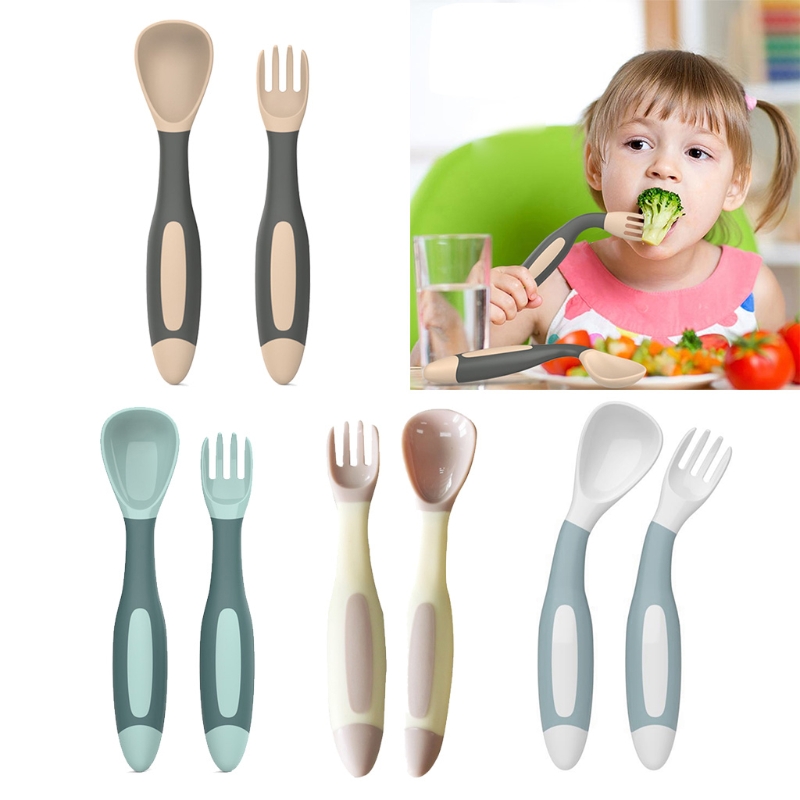 It’s better to take the cutlery yourself, scoop it up from its plate, show by example and explain in words that it’s much tastier and more pleasant to eat this way. Do not start training if the baby is not in the mood, is naughty or does not feel well.
It’s better to take the cutlery yourself, scoop it up from its plate, show by example and explain in words that it’s much tastier and more pleasant to eat this way. Do not start training if the baby is not in the mood, is naughty or does not feel well.
Some children do not want to take a spoon, but they are happy to grab a fork. It's okay if the baby first masters this device. Get him a safety fork with blunt teeth and show him how to use it. The first lessons can quickly tire the baby. If he is tired, do not insist and feed yourself.
Consider the individuality of the child
It is important to always remember that each person is individual, so you need to find your own approach to any of them. In books devoted to the topic of self-feeding, they write that children by the age of one and a half are simply obliged to eat on their own. You should not drive the baby into this framework and strive to achieve the ideal, because some children do not want to eat on their own even by the age of three and demand to be fed, but it is impossible to meet a ten-year-old who has not yet learned to eat on his own.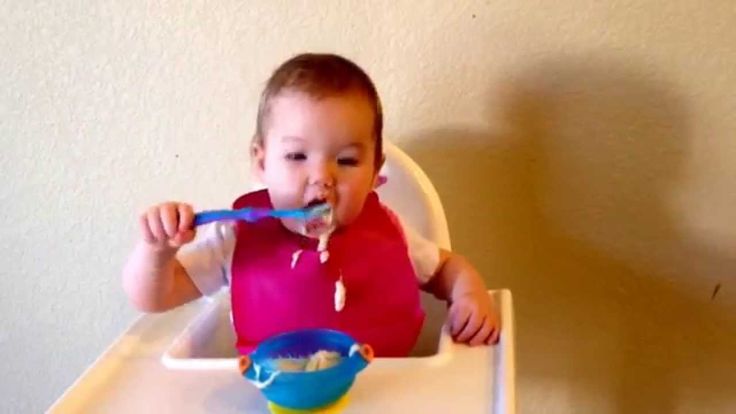
Regular training is very important, as the child must memorize the skills he needs. You can temper the skill in the sandbox. Place an empty bucket next to the baby, give him a spatula and ask him to fill the container with sand.
Interest in eating
Everyone knows firsthand that tasty and healthy food often looks completely unattractive on the plate, but adults, unlike children, understand that taste does not depend on appearance at all. How can you make your child want to eat?
- A good way to decorate a dish. You can cut out flowers, funny faces or stars from products.
- Buy a plate with a nice pattern on the bottom, fill it with food and let your child know that when he eats everything himself, he will be in for a surprise. This will arouse interest in the process of eating itself and allow you to repeatedly use this option.
How to overcome resistance
My wonderful independent baby stopped eating on his own at 2 years .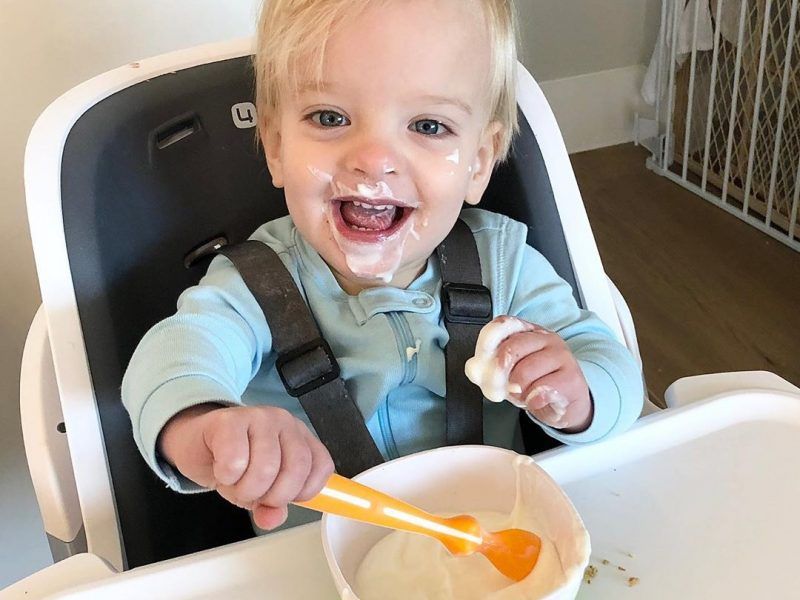 Why? I am still looking for an answer to this question. I came to the conclusion that we are facing another crisis. The child simply stopped eating on its own. Each of my attempts ended with his scream and my tears. Why did I want him to eat on his own? I spent this time at work, because it’s not so easy to do everything with a baby.
Why? I am still looking for an answer to this question. I came to the conclusion that we are facing another crisis. The child simply stopped eating on its own. Each of my attempts ended with his scream and my tears. Why did I want him to eat on his own? I spent this time at work, because it’s not so easy to do everything with a baby.
There was a period when I resigned myself, does not eat on his own - no need, my nerves are dearer to me. Was I right? Now I understand - no! But at that moment everything tripled me. I quickly put food into my open mouth, like a dick, and my maternal instinct is completely satisfied. It took a while and it started to annoy me terribly. Each of my attempts ended in a scandal - the child simply refused to eat. But I found my way. I hope my experience is useful to you.
Every time a child sits down at the table, the child reacts with a cry to the offer to take a spoon. In the end, I went for a trick.![]() I offered him to eat with two spoons. How? I have one (I helped him), and the second is his. He ate one spoon himself, I took the second and fed him. By the end of the meal, the offspring forgot about me and, on his own, smacked his lips with appetite. We gradually moved away from this ritual and in 3 years we forgot about this problem.
I offered him to eat with two spoons. How? I have one (I helped him), and the second is his. He ate one spoon himself, I took the second and fed him. By the end of the meal, the offspring forgot about me and, on his own, smacked his lips with appetite. We gradually moved away from this ritual and in 3 years we forgot about this problem.
Important points:
- If the baby does not eat on his own, and you are eager to teach him, be steady in your desire. Do not give in to the momentary desire to help, to feed. Don't repeat my mistake.
- Do not scold the child if she does not want or does not want to feed herself. Remember the first point - confidence and perseverance is all you need!
What you need to know when getting new experience
Education is hard work. To make this work easier, you should know some nuances:
- Be sure to accustom the baby to the apron. My child is not used to it and after that, we had problems in the garden (in the nursery, children eat in aprons).
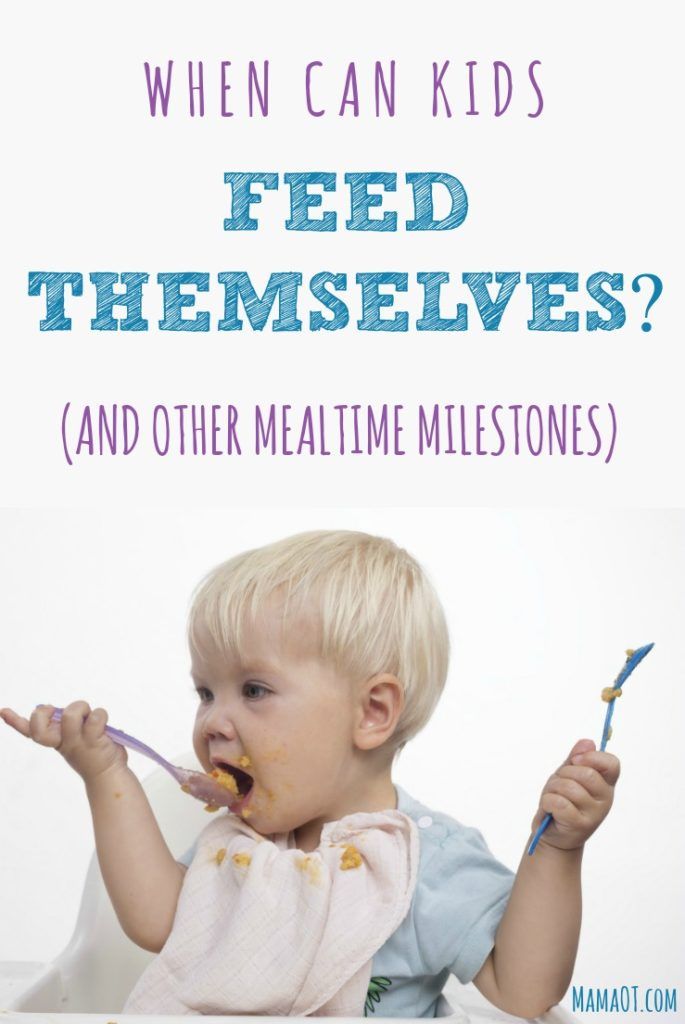 He just didn't want to wear it.
He just didn't want to wear it. - Buy 2 aprons that are easy to clean. You will have to wash it after every meal.
- Make your little one happy - get a beautiful and comfortable cutlery to work with a spoon with joy.
- Again about the apron: the longer, the better. It is very convenient to fill its edge under the bottom of the plate. Then everything that flies past the baby's mouth does not stain him and his clothes.
- Buy a chair that is finished with moisture resistant materials. You will have to wash it (still the floor, the baby, sometimes the walls), after every meal.
- Stock up on patience and love.
So… Algorithm of actions
To make it easier for parents to teach their child to self-feed, experts have developed detailed instructions:
- Lay an oilcloth on the table, and put on a bib for the child.
- Scoop a spoonful of porridge from a child's plate and eat it, smacking your lips with pleasure and pretending to be delighted.

- Give the spoon to the toddler. Until he can hold it, hold his hand with your hand, help scoop up food and bring it to your mouth. Help until the child can hold the appliance on their own.
- When your baby's arms are strong, teach him how to hold a spoon correctly - not in a fist, but with your fingers.
- When giving a child a spoon, take another one yourself. While the child is learning to eat on his own, help him with another spoon. That is, one spoon - to him, one - to you.
At first, the baby will just play with a spoon - stir the porridge in the bowl, smear it on the face and table. Give him time to get used to the cutlery. If you are tired of the fact that the child constantly turns over the dishes, put a plate with a suction cup on the table.
In the same way, you can teach a toddler to use a fork and a non-spill cup (learning to drink from a cup). Start with small portions, making sure the child is interested, and never show your indignation at soiled clothes and furniture.
Helpful Hints
- Be patient. The hands of a one-year-old baby have not yet grown stronger. At first, it will be very difficult for him to hold the spoon, and he will miss her mouth. The training will take from 1 to 6 months;
- Train in different places. A great way to teach a child something is to turn the process into an educational game. Invite your little one to feed the plastic bunnies with sand with a spatula when he plays in the playground. So he will improve coordination of movements, which will come in handy later in a real kitchen;
- Don't leave your baby alone with a full plate of - he may choke or become fussy because he can't eat. In addition, at first, the child will still be able to bring no more than 3-4 spoons to his mouth. Then he will get tired, and you will have to help him;
- Choose the right food. The consistency of food should be such that the child can scoop it up with a spoon and bring it to the mouth.
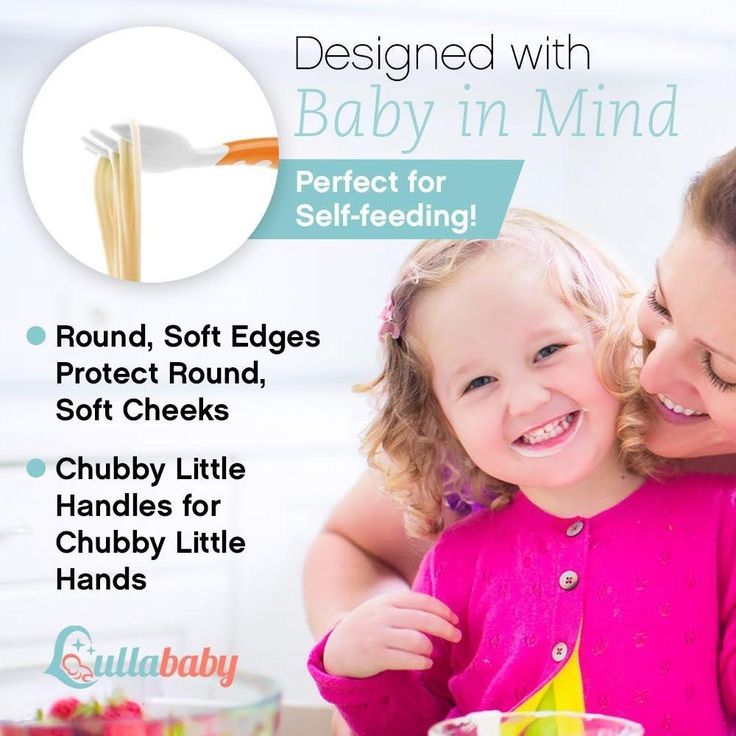 The baby will spill the soup, and take the pieces of food with his hands. Therefore, opt for thick porridge, mashed potatoes or cottage cheese. Do not immediately put a full plate in front of the child, but rather put food in it a little bit;
The baby will spill the soup, and take the pieces of food with his hands. Therefore, opt for thick porridge, mashed potatoes or cottage cheese. Do not immediately put a full plate in front of the child, but rather put food in it a little bit; - Don't forget the plug. Alternate cutlery to help your baby develop fine motor skills faster. At breakfast, did the child try to pick up porridge with a spoon? For lunch, invite him to eat fish meatballs with a safety fork;
- Get everyone in your household involved in learning. If you teach the little one to use cutlery, and the grandmother continues to spoon-feed him, the process will be delayed. The baby will not understand why he should try to do something himself if there are adults for this. Explain your teaching principles to all family members and ask them to follow them as well;
- Follow the schedule. Feed your baby exactly at the same time every day, constantly reinforcing the acquired skills.
 So you can develop a habit in your baby. In addition, eating on a schedule improves digestion;
So you can develop a habit in your baby. In addition, eating on a schedule improves digestion; - Avoid coercion. During the learning process, the child will sometimes act up and refuse to eat on his own. If this happens, feed him yourself, and postpone training until the next meal. When a child is not in a good mood, it will still not work to teach him something;
- Dine with the whole family. It will be easier for a kid to master a spoon if he sees how other people use it. He involuntarily begins to imitate them. For the same reason, in kindergartens, kids quickly learn to eat, dress and go to the potty on their own;
- Invent games to stir up the toddler's interest in learning. You can buy him a plate with a funny picture on the bottom and offer to eat porridge to see the surprise;
- Start with your child's favorite food and only on an empty stomach. The kid will not want to make an effort to eat something tasteless, especially in the absence of appetite;
- Praise the child even for small progress.
